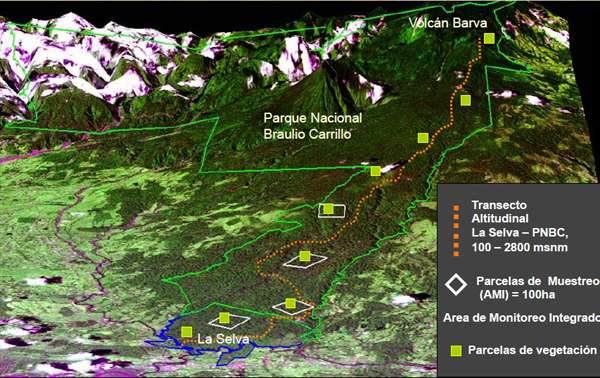Tropical tree communities are moving up mountainsides to cooler habitats as temperatures rise, a new study in Global Change Biology has found. By examining the tree species present in ten one-hectare plots at various intervals over a decade, researchers found that the proportion of lowland species increased in the plots at higher elevations. The study, which was undertaken in Volcan Barva, Costa Rica, adds to a growing body of evidence that climate change is having an impact on species range distributions.
As climate change leads to warmer temperatures, species must respond if they are to survive. One way to do this is to migrate to new habitats that become suitable (and away from old ones that become unsuitable); another way is to adapt to hotter temperatures, but the speed of climate change may be too fast for some species to evolve to keep up. In some cases, if their physiology permits it, species may be capable of tolerating increases in temperature, but the likelihood of this is unknown.
The researchers first turned to herbarium records to calculate the preferred temperature of thousands of tree species, by looking at the geographic location of sampling locations and the temperature ranges they encompassed. With the temperature preferences for each species known, it was then possible to calculate a ‘community temperature score’ for each of the ten study plots, by averaging the preferred temperatures of all species present. A high community temperature score indicated an abundance of species found in the hot lowlands, whereas a low community temperature score reflected the presence of high altitude species from cooler habitats.
 Looking up at a giant tree in the Costa Rican rainforest Photo credit: Rhett A. Butler / mongabay.com
Looking up at a giant tree in the Costa Rican rainforest Photo credit: Rhett A. Butler / mongabay.com
Plots were monitored over the course of a decade, and in nine of the ten plots the community temperature score increased. This indicates a shift in species composition, with the relative abundance of lowland species increasing over time “exactly as predicted under climate-driven upward species migrations,” Kenneth Feeley, lead author of the study with Florida International University and Fairchild Tropical Botanic Garden, told mongabay.com.
These changes corresponded to a mean thermal migration rate of 0.0065°C per year. However, over the past 60 years regional warming has been 0.0167°C per year, so the average migration rate observed across plots is not fast enough to keep up with the rate of warming. Still, encouragingly, when looked at individually, migration in 4 of the 10 plots did keep pace with regional warming.
Changes in species composition can be the result of different processes: species abundance can change without shifts in the overall range distribution, ranges can shift, and ranges can expand or contract. Identifying which of these underlies changes in species composition is important, because “depending on which of these processes is occurring, predictions for the future of ‘migrating species’ will vary from positive (under range expansions), to neutral (under range shifts) to dire (under range contractions),” Feeley explains.
To examine the specific causes of the compositional shifts in the study plots, the researchers measured stem growth, recruitment (the establishment of new trees), and mortality. They found that the main driver behind the increase in the relative abundance of lowland species upslope was in fact the disproportionate death of higher elevation species.
“Our results indicate that dieback is happening much faster than expansion. This means that species’ ranges will shrink. As ranges shrink, species will be more and more prone to extinction,” Feeley said.

Forested mountains in Costa Rica, where tropical trees communities are changing in response to climate change. Photo credit Johanna Hurtado
An earlier study by Feeley and colleagues investigated related questions in the Peruvian Andes and came to similar conclusions, suggesting that their findings may be generally applicable across the tropics.
“The rates of migration that we have documented for the forests of Costa Rica are remarkably similar to what we found in the Peruvian Andes. The rates are also fairly close to the maximum rates of migration recorded for tropical trees during the warming period that followed the last glacial maximum. As such, it appears that what we are observing is trees moving at their fastest,” Feeley said. “In the past, this was fast enough; it is not fast enough now and it certainly won’t be fast enough in the future,”
While range contractions increase the likelihood of extinction for individual species, they also have a broader impact on patterns of biodiversity.
“As species experience dieback at the trailing edges of their distributions due to temperatures becoming intolerably hot, we will get decreases in local diversity through a process that has been termed ‘biotic attrition’,” Feeley said. If species are able to shift their ranges upslope, and not just suffer dieback in the lowlands, “then we may expect an increase in alpha (local) diversity in the mountains over long time periods as large numbers of species move up out of the lowlands and into the highlands. In this case, the real losses of biodiversity are expected in the lowlands where there is no known pool of ‘hot-adapted’ species waiting to fill in the lowlands after the existing species emigrate.”
Migrating to track climate change – either by moving up mountainsides or by moving towards the poles – is not easy: temperature is not the only factor that determines whether a habitat is suitable for a species, it is just the simplest to study in order to predict how species might respond to our warming world.
“Other climatic factors such as precipitation and seasonality can be hugely important for some species as can other non-climatic factors such as soil type and slope. Furthermore, biotic factors such as competition, predation, herbivory, disease, and mutualisms, may also be just as if not more important,” Feeley explains.
“The more realistic you make the models, and the more variables you consider, the number of future options available to species almost invariably decreases.”
Even if species are capable of keeping pace with climate change and move upslope, they will still suffer a reduction in available habitat as land area decreases the further up the mountain they go.
“For example, in Costa Rica there is over 6.5 times as much land area between 1800 m and the highest plot at 2800 m as between 2800 m and the highest point in Costa Rica at 3820 m elevation,” the scientists write. Species already adapted to cooler high elevation temperatures will have nowhere to migrate into. And other problems also face tropical species that are a long way from a mountain to begin with.
“Within the tropics there is no latitudinal gradient in temperature. This is very important because it means that species cannot migrate towards higher latitudes to escape the heat but instead must migrate to higher elevations where it does get invariably cooler,” Feeley explains. “For lowland species in the middle of the Amazon basin where it is remarkably flat, this means that they will have to migrate huge, perhaps impossibly huge, distances before they experience any sort of relief.” Add to that the destruction of habitat, and movement becomes more challenging still.
“If species cannot migrate upslope, then their potential responses to climate change are greatly limited. Indeed, the only options left are to adapt or to acclimate. And given the speed at which the world is now changing, I think it is safe to say that adaptation is not a viable option, at least for large long-lived trees with long generation times. So the question becomes, can lowland trees acclimate to climate change?” Feeley posits. “The future of global diversity depends on the answer to this question but right now we are nowhere close to having that answer.”
Species in the lowland tropics inhabit one of the hottest regions on earth, so it is impossible to gauge their heat preferences above present-day temperatures by looking at their range distributions. However, understanding the upper limit of species’ heat tolerance would vastly improve predictions about species survival in a warming world.

Map showing the team’s study plots (green squares) stretching from the lowlands up the mountain to a height of 2800 metres. Image credit Johanna Hurtado.
“By far the single most important factor is how much warming the species can tolerate. If they can tolerate a significant amount of warming, then our predictions are relatively sanguine. If species are intolerant of warming, then their future will be dependent on migrations and predictions for the tropics become very bleak,” explains Feeley.
To date, the majority of studies examining the potential impact of climate change have focused on North America and Europe.
“In general, there is a dearth of studies looking at the impacts of climate change on the distributions of tropical species. This is despite the fact that the vast majority of species are tropical,” Feeley told mongabay.com. “We desperately need to fill the void and have more studies from the tropics. To do these studies we need a better and more systematic system of ecosystem monitoring plots and more importantly, but also harder, a better understanding of the complex abiotic (non-biological) and biotic (biological) factors that regulate species distributions and dynamics.”
Feeley and colleagues continue to monitor their study plots in Costa Rica and Peru, and are expanding their research to better understand the processes that determine species range distributions and movements.
“We are in the initial phase of a large-scale transplant study in which we are moving thousands of seedlings of dozens of tree species up and down the slopes of the Andes under various experimental treatments in order to identify the specific biotic and abiotic factors that limit their distributions,” he says. “Once we have this information we can build it into improved predictions for the fate of these species on a warmer planet.”
The best hope for conserving forests in the face of climate change, and climate-driven migrations, is to anticipate species movements, says Feeley.
“We need to expand the time scale of our thinking and determine not just where species are today but where they will be a hundred years from now. And then we need to protect both of those places and everything in between.”
Paper: Feeley K.J., Hurtado J., Saatchi S., Silman M.R., and Clark D.B. 2013. Compositional shifts in Costa Rican forests due to climate-driven species migrations. Global Change Biology, Available Online. DOI: 10.1111/gcb.12300
Related articles
Climate change could kill off Andean cloud forests, home to thousands of species found nowhere else

(09/18/2013) One of the richest ecosystems on the planet may not survive a hotter climate without human help, according to a sobering new paper in the open source journal PLoS ONE. Although little-studied compared to lowland rainforests, the cloud forests of the Andes are known to harbor explosions of life, including thousands of species found nowhere else. Many of these species—from airy ferns to beautiful orchids to tiny frogs—thrive in small ranges that are temperature-dependent. But what happens when the climate heats up?
Which ecosystems are most vulnerable to climate change?
(09/16/2013) New research highlights the world’s most (and least) vulnerable ecosystems to climate change. The study, published in Nature Climate Change, is the first to combine anticipated climatic impacts with how degraded the ecosystem is due to human impacts, creating what scientists hope is a more accurate list of vulnerable regions. The most endangered regions include southern and southeast Asia, western and central Europe, eastern South America, and southern Australia.
Global warming may ‘flatten’ rainforests
(09/12/2013) Climate change may push canopy-dwelling plants and animals out of the tree-tops due to rising temperatures and drier conditions, argues a new study published in Proceedings of the Royal Society B. The development may be akin to ‘flattening’ the tiered vegetation structure that characterizes the rainforest ecosystem.